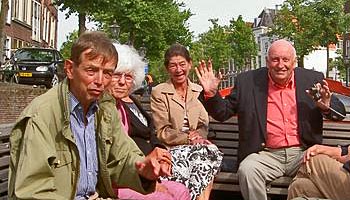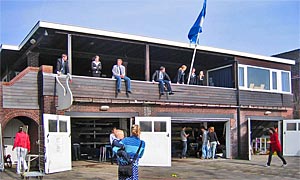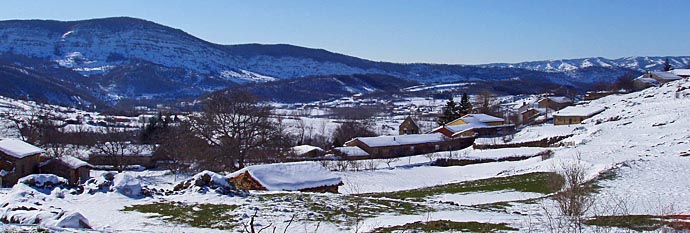12 - Stories from Asturias 1958 :
by Michael Furstner
------------------------
Previous - Next - Contents
Barrios Quartzsite : silent witness to our only fight
 Hauk Fischer and I have been the closest of friends from the first day we met
shortly after arriving at Leiden
University and joining the same student Yearclub Pimpernel in October 1955.
Hauk Fischer and I have been the closest of friends from the first day we met
shortly after arriving at Leiden
University and joining the same student Yearclub Pimpernel in October 1955.
For the first 4 years of our
study we were virtually inseparable and known by all as Fisch & Furst. Little
wonder, for besides being Club friends we both were Geology students, both
coxswains in the Leidse Student Rowing Club Njord, and after the first
year also lived in the same student house (Hogewoerd 30) for several years.
 The first year at Njord was very demanding which we both suffered through
stoically. We each were in charge of an eight rowing crew. All through that cold
and wet winter of 55/56 we each spent 6 hours on the water every single day, training
with our coach and crew.
The first year at Njord was very demanding which we both suffered through
stoically. We each were in charge of an eight rowing crew. All through that cold
and wet winter of 55/56 we each spent 6 hours on the water every single day, training
with our coach and crew.
The full crew was first split up into two fours
which we took out for 2 hours each (one after the other), then a final 2 hour session
with the complete eight. We were continually wet through, very cold and found
little time for study those days.
Then when the year's race rowing season started in the
late Spring we had to abandon it early summer in order to attend geological excursions
and fieldwork.
Hauk and I both were hot fans of
the novelist John Steinbeck, and on all our hitch hiking trips, excursions
and joint fieldwork mimicked the lifestyles of those loveable simple characters of
Tortilla Flat and Cannery Row.
On geological excursions we usually
shared a room together, and sometimes even a double bed. But here is where our closeness
firmly ended. Before bedtime we would tie the shoelaces of our boots together into a
long string, span it across the middle of the bed from head to foot end, and if
either one during sleep accidentally nudged even as much as a heel across this "border" he was
forcefully kicked out off bed by the other. This was our firm, mutually agreed upon rule.
Our friends were amazed at the fact that we never ever quarreled, and on a few occasions
tried to start one off between us, but never with any success. Then, at the end of our 3rd
year, in the summer of 1958, we did a joint mapping exercises around Felechas in Asturias.
 The geological structure of the area around Felechas (the "Felechas syncline")
was like the upper half of a table spoon, slightly incline upwards. The "metal" of the
spoon consisted of the oldest rocks (upper Ordovician), the Barrios Quartzsite,
a light grey very hard sparkling crystalline rock, which formed the highest
mountain chain just inside the northern perimeter of our designated mapping area.
The geological structure of the area around Felechas (the "Felechas syncline")
was like the upper half of a table spoon, slightly incline upwards. The "metal" of the
spoon consisted of the oldest rocks (upper Ordovician), the Barrios Quartzsite,
a light grey very hard sparkling crystalline rock, which formed the highest
mountain chain just inside the northern perimeter of our designated mapping area.
Within this Barrios
Quartzsite "spoon" were concordant layers of subsequent younger and softer sedimentary rocks of
Silurian and Devonian age, sloping gradually downwards and south towards the main valley.
The first four weeks or so in Felechas Hauk and I spent in complete harmony. Then,
suddenly and unexpectedly, high up, near the top of the mountain, amongst
the sparkling boulders and rock formations of the Barrios Quartzsite,
floating as it were within an irregular and steeply sloping carpet of green grass, we
suddenly burst out in a most heated argument.

Wandering around the rocks
some 40 paces apart we yelled and shouted at each other at the tops of our voices.
About what ?? I can't remember, other than that it was about a geological, rather than a
personal matter.
After perhaps a quarter of an hour of this, we both stopped and
silently descended down to our base camp. There we had a glass of wine, and were the
best of friends again until this very day. No one of our friends ever heard about this.
There had been only one witness, silent and some 300 million years old : the Barrios
Quartzsite.
 I think it was a few days after our fight, while on our way home that we found at the
end of a mountain spur a large wooden cross lying on the ground, obviously blown over
by a recent storm. It was made from an old telephone pole, 4 meters (13ft) high with a 2
meter cross bar.
I think it was a few days after our fight, while on our way home that we found at the
end of a mountain spur a large wooden cross lying on the ground, obviously blown over
by a recent storm. It was made from an old telephone pole, 4 meters (13ft) high with a 2
meter cross bar.
Hauk and I dug a deep hole into the rubble, placed the cross
upright in it and filled the hole around it with stones. The spur overlooked the EW
valley running between Sabero, Felechas and Boñar, and anyone in the valley
looking up could now once again see the cross.
Back home we pointed this out to the
villagers who were much pleased with our effort. We were also immediately invited to
the following Sunday Mass in the Felechas Chapel. This we did.
 Neither Hauk nor I had ever been to a Roman Catholic service before and it struck us
with great force. I remember that at the end of it we were much upset by the very naive
and (what we considered to be) outright pagan rituals. How could anyone believe
in this nonsense we asked ourselves.
Neither Hauk nor I had ever been to a Roman Catholic service before and it struck us
with great force. I remember that at the end of it we were much upset by the very naive
and (what we considered to be) outright pagan rituals. How could anyone believe
in this nonsense we asked ourselves.
Both of us were much inclined to race back up
onto that hill top and pull the cross down again, but in the end common sense got the
better of us and we let it stay there, making no comments about our feelings to the
locals.
In fact knowing us to be non Catholics several of the villagers told us that
they had prayed for the salvation of our souls that morning, which was, if nothing else,
a very endearing thought.
Next Page -
Top of Page
Copyright © 2010 Michael Furstner
|




 I think it was a few days after our fight, while on our way home that we found at the
end of a mountain spur a large wooden cross lying on the ground, obviously blown over
by a recent storm. It was made from an old telephone pole, 4 meters (13ft) high with a 2
meter cross bar.
I think it was a few days after our fight, while on our way home that we found at the
end of a mountain spur a large wooden cross lying on the ground, obviously blown over
by a recent storm. It was made from an old telephone pole, 4 meters (13ft) high with a 2
meter cross bar.  Neither Hauk nor I had ever been to a Roman Catholic service before and it struck us
with great force. I remember that at the end of it we were much upset by the very naive
and (what we considered to be) outright pagan rituals. How could anyone believe
in this nonsense we asked ourselves.
Neither Hauk nor I had ever been to a Roman Catholic service before and it struck us
with great force. I remember that at the end of it we were much upset by the very naive
and (what we considered to be) outright pagan rituals. How could anyone believe
in this nonsense we asked ourselves.